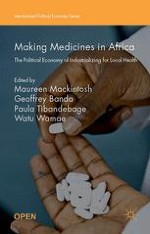Open Access 2016 | Open Access | Buch

Making Medicines in Africa
The Political Economy of Industrializing for Local Health
herausgegeben von: Maureen Mackintosh, Geoffrey Banda, Paula Tibandebage, Watu Wamae
Verlag: Palgrave Macmillan UK
Buchreihe : International Political Economy Series